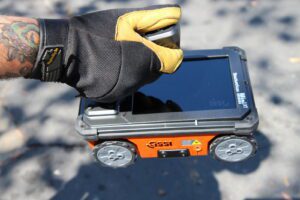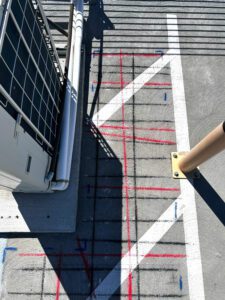Concrete Scanning Services by 2M General Engineering: Precision Meets Innovation
At 2M General Engineering, we understand the critical nature of identifying what lies beneath the surface of concrete structures before you commence cutting, drilling, or coring. The absence of this crucial information can lead to job delays, cost overruns, and potential damage to your industry reputation. We use specialized ground penetrating radar (GPR) technology to offer a non-destructive and non-intrusive solution, ensuring the safety and efficiency of your projects.
No Guesswork, Concrete Facts
Why Choose 2M General Engineering for Concrete Scanning?
 Professional Expertise: Leveraging high-frequency GPR antennas, our techs can detect both metallic and non-metallic objects within concrete structures up to 24 inches deep, depending on conditions. This allows for precise identification and mapping of rebar, conduits, post-tension cables, and radiant tubing, significantly reducing the risk of costly mistakes.
Professional Expertise: Leveraging high-frequency GPR antennas, our techs can detect both metallic and non-metallic objects within concrete structures up to 24 inches deep, depending on conditions. This allows for precise identification and mapping of rebar, conduits, post-tension cables, and radiant tubing, significantly reducing the risk of costly mistakes.- Comprehensive Solutions: The challenge of outdated or inaccurate construction plans is all too common in our industry. GPR technology shines in these scenarios, providing a reliable method forrevealing the actual conditions within concrete structures, far surpassing the capabilities of other tech
nologies. - Efficient and Safe: Ground penetrating radar offers instant, on-site results and the ability to save scanning data digitally for off-site review. This includes high-resolution rebar mapping and detailed reporting, ensuring a comprehensive understanding of your project’s subsurface conditions.
Our Three-Step Process:
- Assessment: Our initial evaluation of the workspace aims to understand the concrete’s condition, rebar and post tension cable patterns within the concrete slab and any potential obstacles that will affect the area of interest.
- Scanning: With results immediately visible, we meticulously mark out the detected objects directly on the concrete, creating a clear picture of the area’s subsurface layout.
- Documentation (Optional): Direct marking on the job site is standard, but we also provide detailed documentation and 3D modeling upon request, allowing for a tailored approach to each project.
What GPR Concrete Scanning Can Detect:
 Rebar and Tendons: Avoid structural damage by precisely locating these before commencing work.
Rebar and Tendons: Avoid structural damage by precisely locating these before commencing work.- Conduits and Pipes: Identify hidden electrical wiring or plumbing to prevent accidents.
- Post-Tension Cables and Voids: Crucial for maintaining structural integrity and safety.
- Slab Thickness and Deterioration: Essential data for planning and executing construction tasks effectively.
The 2M Difference:
Utilizing GSSI Structure Scanners, our trained professionals can deliver unparalleled accuracy in detecting subsurface anomalies, ensuring that your projects proceed without unforeseen setbacks.
No Guesswork, Concrete Facts
Frequently Asked Questions
Concrete scanning uses ground penetrating radar (GPR) technology to safely and non-invasively detect objects and features within concrete structures up to 24 inches deep. This process is crucial for identifying the position of rebar, conduits, post-tension cables, and other hidden elements before drilling, cutting, or coring, to prevent structural damages, job delays, and cost overruns. It ensures the safety of the construction environment by avoiding costly mistakes.
Our concrete scanning services are essential for professionals involved in construction projects that require concrete coring, cutting, drilling, or sawing. This includes project managers, construction workers, engineers, and anyone who needs to ensure the structural integrity and safety of their project before proceeding with work on concrete structures.
Our concrete scanning process involves three steps: First, we assess the workspace to identify any potential scanning issues. Next, we perform the scanning, where results are immediately visible, and objects are marked on-site. Finally, we offer the option to develop a 3-D model of the scan for a detailed review, allowing precise planning for drilling, coring, or cutting into the concrete.
Yes, GPR concrete scanning is versatile and can be used to locate rebar, conduits, and other objects not only in floors but also in vertical surfaces and ceilings. This capability ensures comprehensive safety and planning for projects involving any concrete structure.


 Professional Expertise: Leveraging high-frequency GPR antennas, our techs can detect both metallic and non-metallic objects within concrete structures up to 24 inches deep, depending on conditions. This allows for precise identification and mapping of rebar, conduits, post-tension cables, and radiant tubing, significantly reducing the risk of costly mistakes.
Professional Expertise: Leveraging high-frequency GPR antennas, our techs can detect both metallic and non-metallic objects within concrete structures up to 24 inches deep, depending on conditions. This allows for precise identification and mapping of rebar, conduits, post-tension cables, and radiant tubing, significantly reducing the risk of costly mistakes. Rebar and Tendons: Avoid structural damage by precisely locating these before commencing work.
Rebar and Tendons: Avoid structural damage by precisely locating these before commencing work.




At 2M General Engineering, we prioritize precision, safety, and efficiency. Our use of high-frequency GPR antennas allows us to detect both metallic and non-metallic objects within concrete, providing instant, on-site results. Our process is designed to overcome the challenges of outdated or inaccurate construction plans, offering comprehensive solutions and detailed documentation for our clients. Our expertise and state-of-the-art technology ensure that your projects proceed without setbacks, maintaining structural integrity and safety.